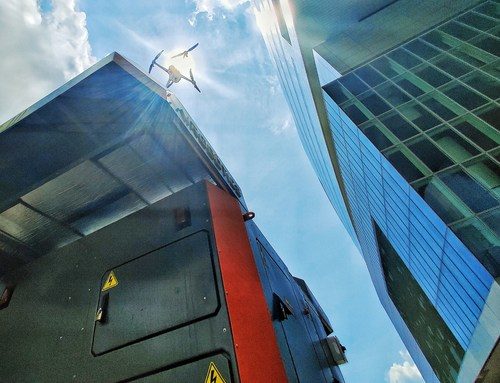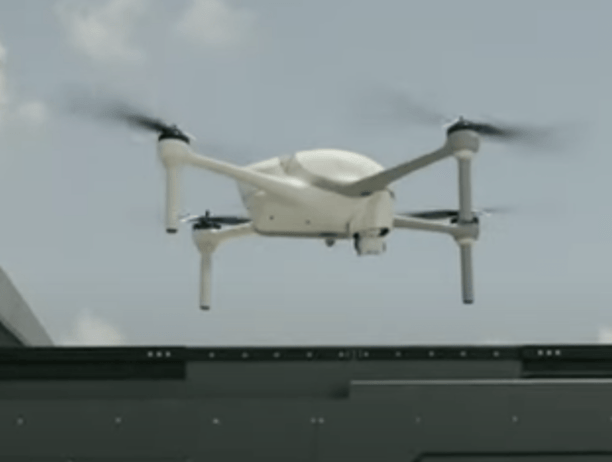Public safety agencies, industry rely on drone-in-a-box systems
By DRONELIFE Features Editor Jim Magill
A multi-vehicle accident snarls traffic on Texas State Highway 130. The Texas Department of Public Safety (DPS) dispatches a drone housed in a pre-positioned nest to the scene to collect visual data from the wreck site.
After completing its mission, the UAV returns to its docking station, part of a network of such sites established as part of the state’s 90-mile Intelligent Infrastructure Economic Zone (IFEZ), where it’s battery is changed out in preparation for its next flight on behalf of the Austin Fire Department or one of the multitude of private high-tech industries situated along the corridor.
In the far western part of the state, an alarm on a piece of equipment on an oil well pad signals a malfunction. Rather the dispatching a crew to the scene in a truck, an operator in Houston orders a drone enclosed in a nearby docking station to the site to check out the alert.
These are just two examples cited this week by speakers at the Energy Drones + Robotics Summit in The Woodlands, Texas, of the ways in which public safety officials and private companies are increasingly turning to drone-in-box solutions to respond to emergency situations quickly and safely.
“What we’re going to see is strategically placed docking stations that can cover a large part of a customer’s area,” said Hyden Bradfield, a strategic solutions architect with reality-capture software company DroneDeploy.
The docking stations are placed in selected sites throughout the oil-rich Permian Basin of West Texas, to enable a drone to be quickly dispatched to remote energy facilities. In addition, to efficiently getting eyes in the sky in the event of an emergency situation, the network of drone nests also provides a vast workflow improvement to the old way of doing drone inspections of facilities.
“Right now, the current workflow with a manually operated drone is: your pilot needs to drive to the site, fly the site as far as he can within his visual line of sight, pack up the drone, change the battery, drive to another site, and do the same on repeat,” Bradfield said.
In this way, drone pilots would have to spend hours on the road traveling from one energy site to another. “I used to do this back in the day. I’d spend a whole day driving and doing inspections with drones. You get fatigued, you get tired, and then you have to drive an hour home and it’s horrible.”
Deploying drones from a network of strategically placed docking stations allows the pilot in command to operate several UAVs from a remote location, dozens or hundreds of miles away. “They’re going to be able to automate the way they collect data and achieve more in a lot less time, and they’re not putting themselves at risk about being on the road,” he said.
Public safety benefits
Susan Roberts, vice president of strategy and business development for drone and software producer Ondas Holdings, said drone-in-box solutions for public safety agencies can range from simple drone-and-charging-station set-up to serve a small town to much more sophisticated systems for large urban areas.


“There’s a range of what drone in the box can mean and one size does not fit all,” she said. “Not everybody needs the super deluxe model of a drone box.” Many customers can get away with housing their drone in an enclosure that keeps it out of the weather and provides a simple battery recharge option.
Ondas, which served as a lead commercial partner with the Austin-based Autonomy Institute in the development of the IIEZ, offers a high end drone-in-a box solution, the Optimus System, designed for industrial and government applications.
“Our box has a robotic arm and will automatically replace the battery and will automatically replace the payload,” she said. The system can support up to 11 battery changes and replace up seven payloads allowing its drone to remain on mission almost continuously with minimum downtime. “For instance, we’ve been flying, at one police department for the last six years nonstop with the same box,” Roberts said.
“We have about a two-and-a-half-minute downtime in between flights where the mechanical arm is taking out the battery, replacing it, putting in a new payload. And then we have a battery-management station inside of our box that will purposefully discharge that battery safely and effectively.”
When choosing a drone-in-the-box solution for public safety operations, agencies should be mindful of their individual needs and not just adopt the first system they see, said Jason Day, UAS program manager for the Texas DPS.
“Everybody wants the shiny object because their chief went to a conference and heard that somebody had a drone-in-a-box,” he said. “We try to talk them off the ledge, saying, ‘You need to figure out how you’re going to afford this technology and what it’s going to do for you.’”
Drone-in-a-box solutions for emergency management
Drone-in-a-box systems can be especially useful in helping both public safety agencies and private industries respond to natural disasters, such as hurricanes, floods or tornados.
Roberts said her company’s docking stations are hardened to protect against severe whether events. Although they have not yet survived a hurricane season along the Gulf Coast, Ondas’s boxes have withstood extreme weather conditions in other parts of the country.
“We’ve been baking down in the sun in the deserts for, with temperatures of 125 degrees for six years. So, we know we work in heat,” she said.
The Ondas system has also been useful in collecting pre-disaster data, such as performing topographic surveys of low-lying areas before a storm hits to assess an area’s susceptibility to flooding, or examining highways and bridges for potential weak points that might fail in the event of a storm.
“Talking about emergency management, the United States has done a really, really good job after the disaster and not as good of a job before the disaster. We could use those drones before the disaster,” she said.
Day said the early success of the drones in boxes deployed along the IIEZ in the Austin area could pave the way for a far more ambitious public/private industry project, a network of drone docks envisioned for the Texas Gulf Coast to respond to hurricanes and other natural disasters.
Proponents of such a system call for stringing a drone box every five or 10 miles along the coast, which would provide constant UAV coverage of the coast, both during daylight and nighttime hours.
“We’re thinking about everybody, not just public safety, but also private entities, oil, gas, insurance, electricity providers. Can that be done and can that be actually stable in today’s market? Yeah, absolutely,” he said.
Read more:

 Jim Magill is a Houston-based writer with almost a quarter-century of experience covering technical and economic developments in the oil and gas industry. After retiring in December 2019 as a senior editor with S&P Global Platts, Jim began writing about emerging technologies, such as artificial intelligence, robots and drones, and the ways in which they’re contributing to our society. In addition to DroneLife, Jim is a contributor to Forbes.com and his work has appeared in the Houston Chronicle, U.S. News & World Report, and Unmanned Systems, a publication of the Association for Unmanned Vehicle Systems International.
Jim Magill is a Houston-based writer with almost a quarter-century of experience covering technical and economic developments in the oil and gas industry. After retiring in December 2019 as a senior editor with S&P Global Platts, Jim began writing about emerging technologies, such as artificial intelligence, robots and drones, and the ways in which they’re contributing to our society. In addition to DroneLife, Jim is a contributor to Forbes.com and his work has appeared in the Houston Chronicle, U.S. News & World Report, and Unmanned Systems, a publication of the Association for Unmanned Vehicle Systems International.


